Someone once commented that the 1938-45 ‘Badge of the Colony’ series is possibly the most studied set of stamps in Barbados philately, as it has returned the most number of constant flaws of any of the sets of Barbados Stamps.
A long time favourite of the George VI collectors, this series was a reprise of the earlier George V set which ran from 1925-35 (SG229-239), which differed in that all the stamps in that set had the inscription ‘Postage and Revenue’ at the top of the stamp.
The earlier set ranged from ¼d to 3/- and contained thirteen values, and the new set, the first issues for which appeared on 3rd January 1938, ran from ½d to 5/-, also contained just thirteen values.
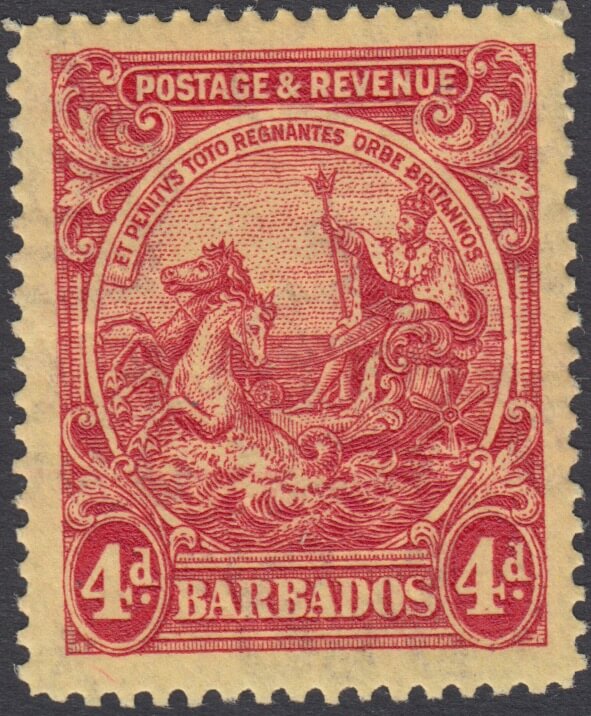
What is so surprising though is that the first set ran for ten years, the second for nine, yet the second set contains sixteen different stamps to collect, just to obtain a full set, and no fewer than seventeen visible flaws, where the earlier set has none.
What was it about this series that generated so many constant flaws?
The listed flaws of the Barbados ‘Badge of the Colony’ 1938-45 definitives
I have yet to see a single coherent reason for so many flaws in this series, but when you consider the time and the circumstances, with the set running throughout the duration of World War Two, it’s understandable that there might be variances in the colours and the printing quality. Add to this the fact that this era saw an explosion in mail volumes globally and it’s easy to see that the likelihood of flaws could increase during this period, as demand for stamps increased.
Currently, Stanley Gibbons list seventeen visible flaws in this series as well as a number of watermark errors that relate to an error within the paper stock. Of these visible flaws, however, there are only seven different and they occur across just 5 different denominations.
The complete list is as follows;
Barbados Badge of the Colony 1938-45 Flaws
|
Flaw Description |
Value |
Colour |
Row/Position |
SG Cat Number |
|
Recut Line |
½d |
Green |
Row 10/6 |
SG248a |
|
½d |
Yellow-Bistre |
Row 10/6 |
SG248cb |
|
|
Extra Frame Line |
2d |
Claret |
Row 11/9 |
SG250ca |
|
2d |
Carmine |
Row 11/10 |
SG250da |
|
|
Mark on Central Ornament |
2½d |
Ultramarine |
Row 1/3, 2/3, 3/3 |
SG251a |
|
2½d |
Blue |
Row 1/3, 2/3, 3/4 |
SG251bb |
|
|
Vertical Line over Horse’s Head |
3d |
Brown |
Row 4/10 |
SG252a |
|
3d |
Blue |
Row 4/10 |
SG252ca |
|
|
Flying Mane |
4d* |
Black |
Row 4/1 |
SG253a |
|
Curved Line at Top Right |
4d* |
Black |
Row 7/8 |
SG253b |
|
Cracked Plate |
4d* |
Black |
Row 6/10 |
SG253c |
*these appear on both the perf 13½ x 13 and perf 14 stamps
Having spoken to a number of collectors, there are still uncertainties over what some of the flaws look like and indeed how to find them, so the following visual listing will hopefully shed some light on that.
Recut Line
The recut line flaw is, I have found, one of the hardest to find. It’s not that it’s particularly scarce, more that even when you are looking at it you can still be left scratching your head, wondering if this is really it.
Of course, the best way to identify this flaw is within a full pane of stamps as once you see it in context with the stamps surrounding it, the flaw becomes much easier to see.
In both the Green and Yellow-Bistre printings of the ½d this flaw can be found on row ten of the sheet, position six. And it only occurs on the ½d values in this set and no other.
When you see the flaw, it looks very much like someone has drawn a short darker line running from the top right ornament on the stamp, inwards towards the middle, by no more than a couple of millimetres. In the catalogue, they put a black arrow on the image to point it out and even then you can still be left wondering.
The images below give you an idea of how to find and identify this flaw.
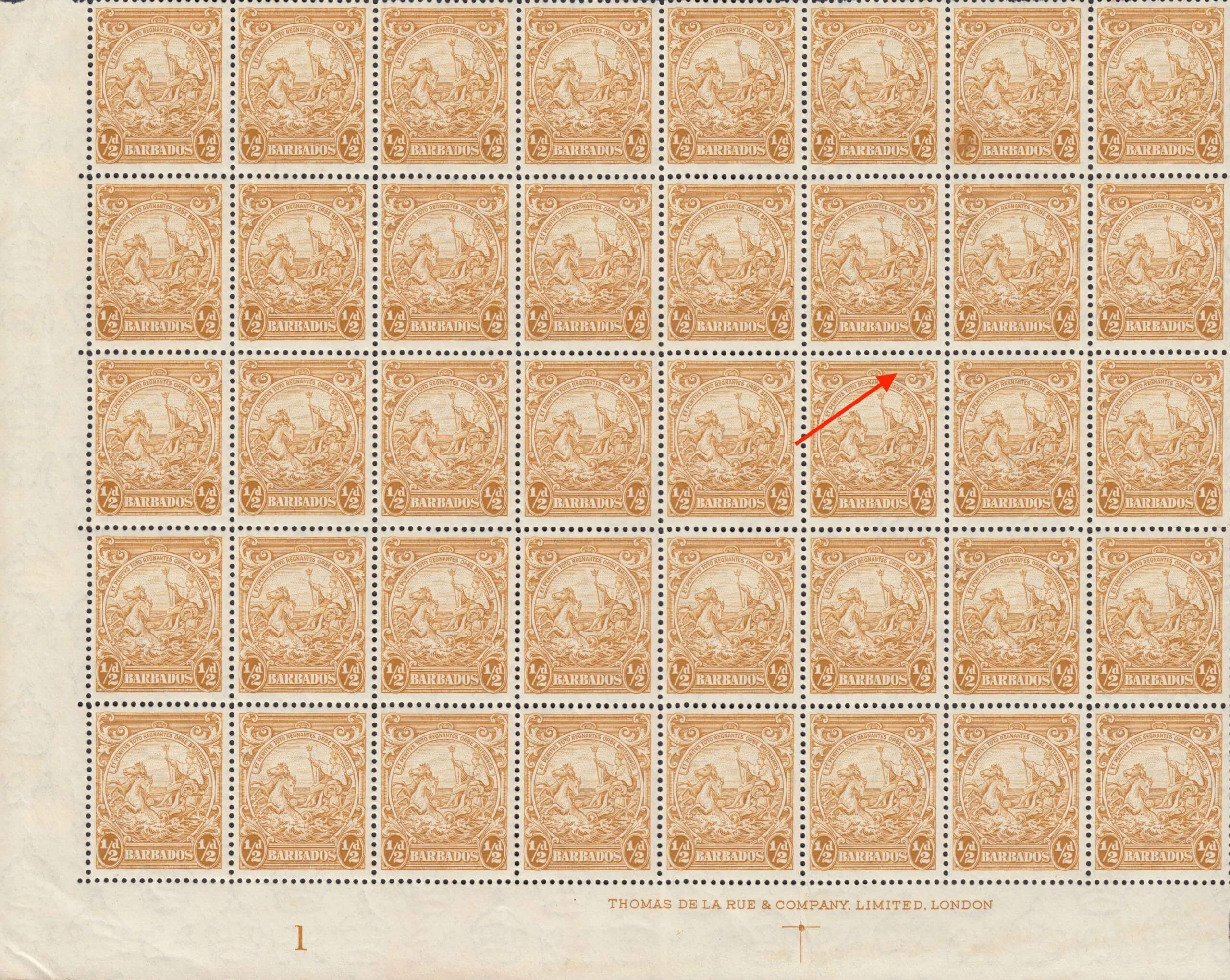
As you can see, even with the big red arrow showing you where it is, it’s almost impossible to see. That’s because, as noted earlier, it’s a very small darker line, and that hardly stands out in a sheet this size.
Let’s take a slightly closer look;
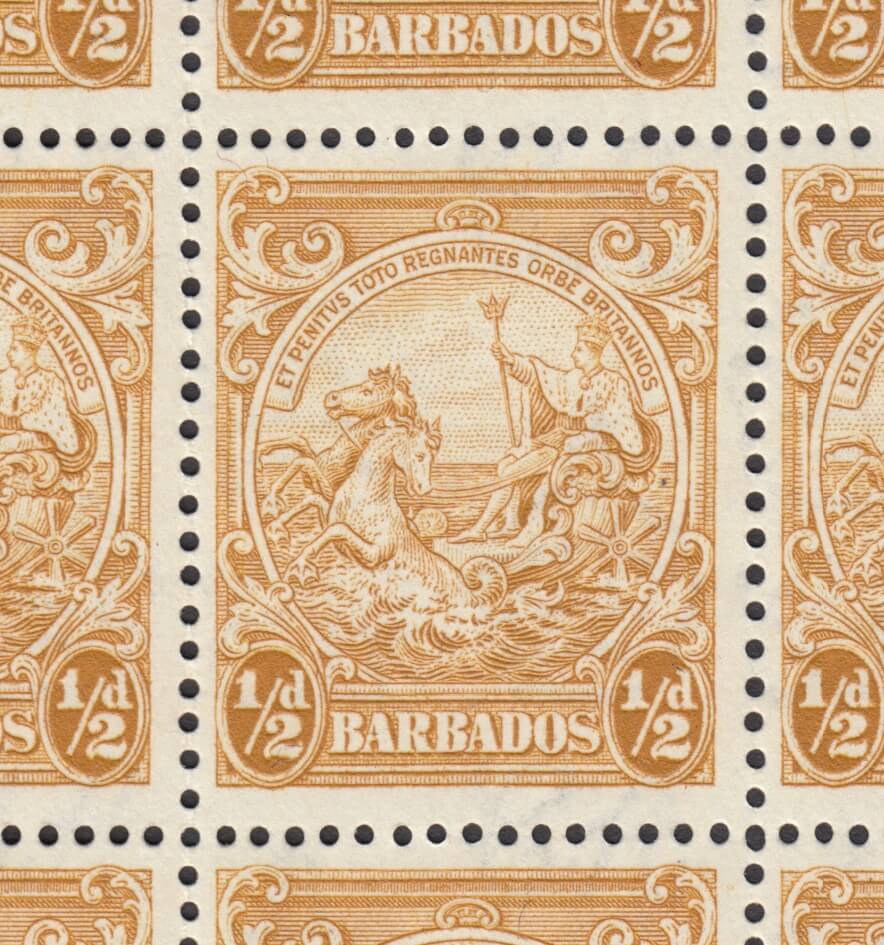
Now we are nearer in there does appear to be something there, but without it being explicitly pointed out, you’d be hard-pressed to correctly identify the flaw.
Let’s take a real close up view and see if it becomes obvious;
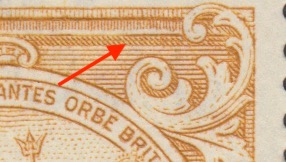
Finally, this close in we can see the flaw. Yes, that short darker line is the Recut Line Flaw which is so sought after. In the current Stanley Gibbons ‘Part 1’ 2020 the Recut Line flaw, mint on the ½d green is catalogued at £650.
Definitely worth keeping an eye out for this one.
Extra Frame Line
In contrast with the Recut Line, this flaw is easy to see with the naked eye. About a year ago, when we were all allowed to visit stamp fairs (!), a dealer was showing me some random pages of Barbados Stamps he was selling and he pulled out a page of this issue, which a collector had mounted as a set.
I could immediately see the extra frame line on the 2d value and promptly bought the whole page, just for the flaw.
Much like the Recut Line, however, unless you know what you are looking for it can be quite hard to spot.
So, how best to describe it?
Well, the Extra Frame Line is only found on the 2d Claret or Carmine and the best way to describe it is if you were asked to draw a single line border around the outside of the stamp design and by mistake, drew a very faint second line, parallel to the right hand border, and then you didn’t rub it out before finishing the job, that would be the Extra Frame Line.
The line isn’t a full line either as it tapers towards top and bottom, meaning the most obvious place to see it is right in the middle of the stamp.
Here is, as it appears on a block; can you see it with the naked eye?
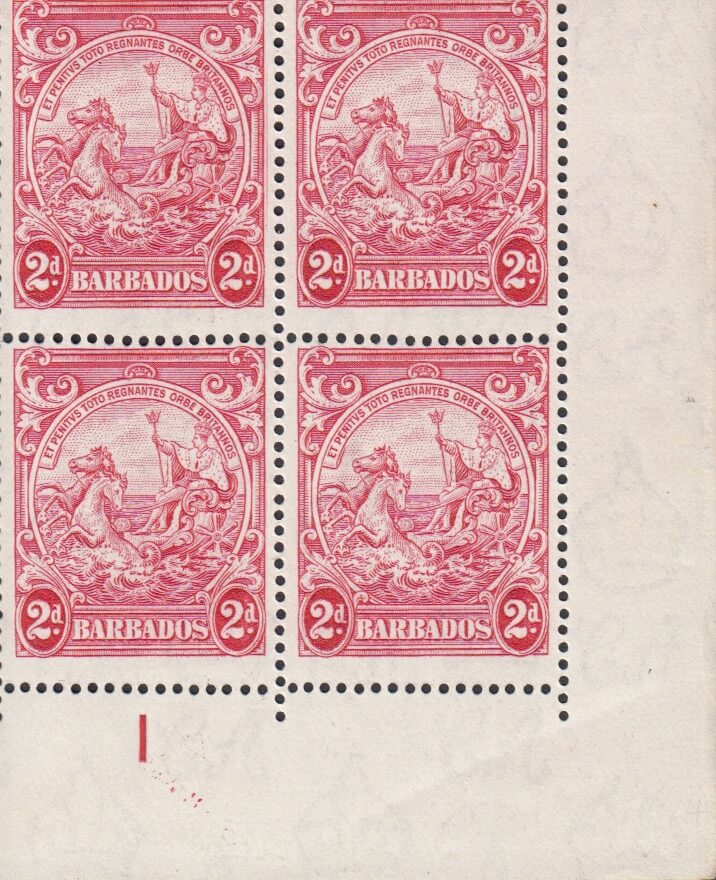
Again, whilst this one is visible when you know what you are looking for, it’s better in close up.
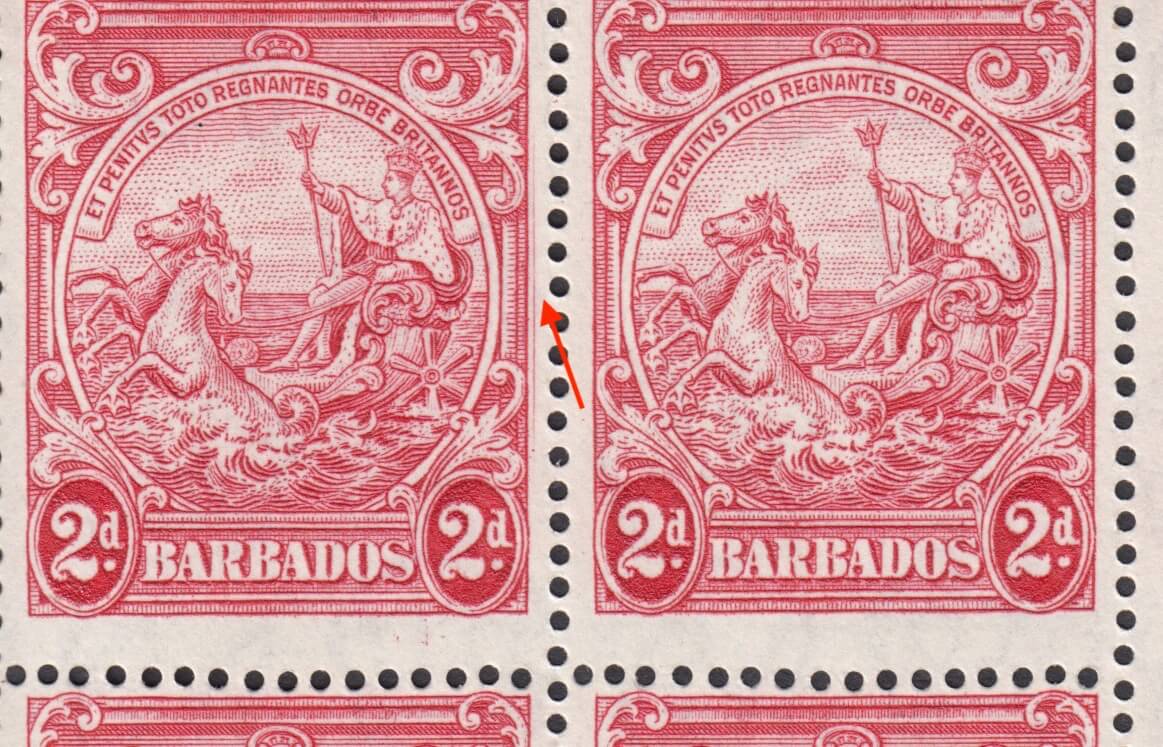
Now the arrow is in place you can see it a lot clearer. It’s like a ‘shadow’ of the frame line but it doesn’t extend the whole length of the frame. And when we move in for an ultra close up you can see it clearly;

Mark on Central Ornament
This flaw is not only easy to see, but it appears three times on the complete sheet so it should be more frequently found in mint or used copies.
The flaw actually looks like an over inking flaw and means that a darker blue blob appears on the ornament in the centre of the design, just below the frame. If you see it in position against other stamps in the row or sheet, you can see clearly that there is something different about it. When assessing a single stamp, however, with nothing to compare against, it can be a little bit harder, though as it’s such a striking error it does tend to stand out a bit more than some of the other flaws.
The flaw only appears on the 2½d stamps in this series, in both the blue and ultramarine shades and is well worth looking out for, especially on blocks that are for sale.
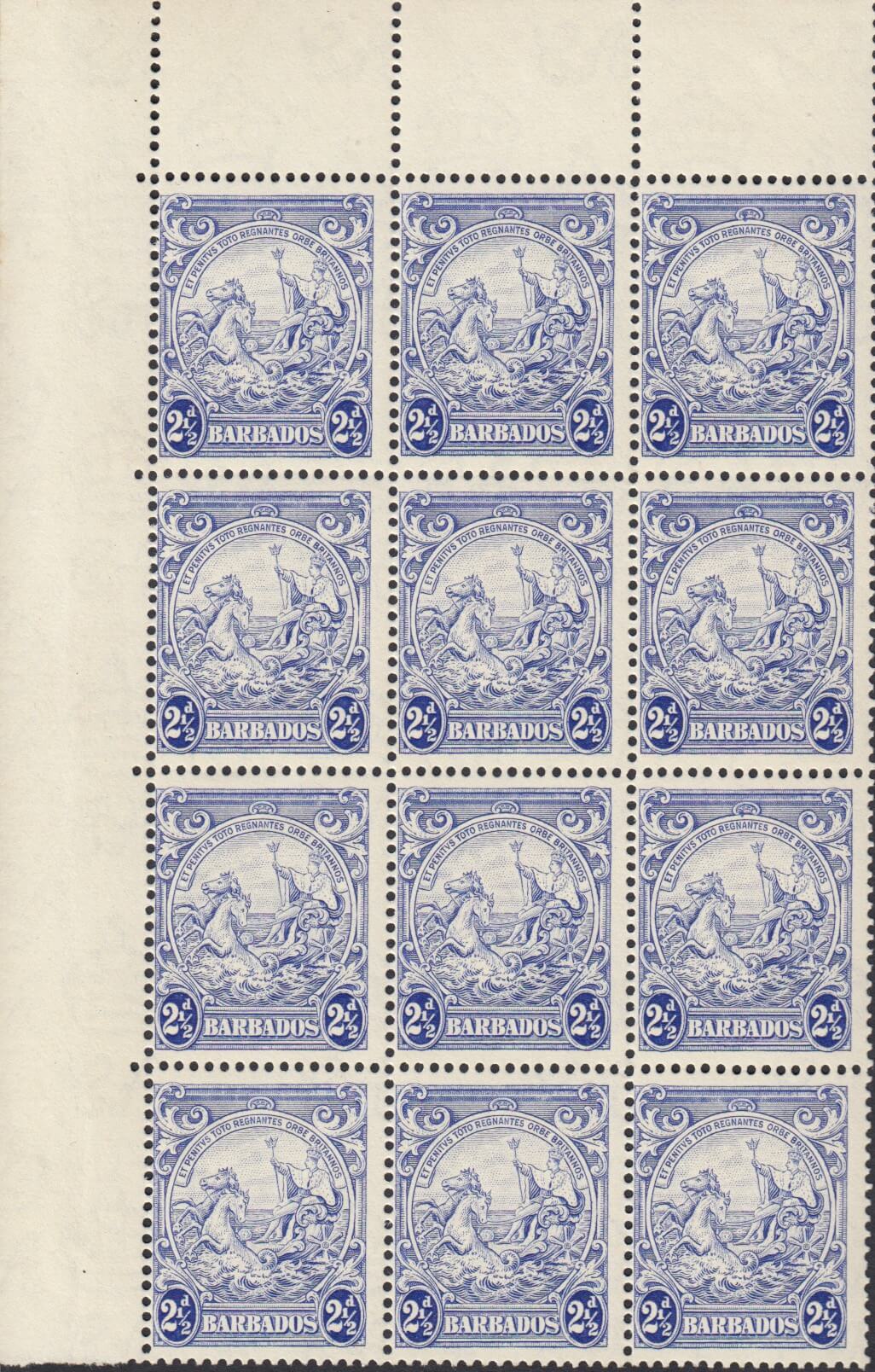
When faced with a block like this, again it can be hard to spot, but if you look at the right-hand column and the central ornament of the first three stamps, you can see a blue ‘blob’.
As we get closer it becomes more obvious;

And finally, when seen in close up it becomes quite an obvious flaw.
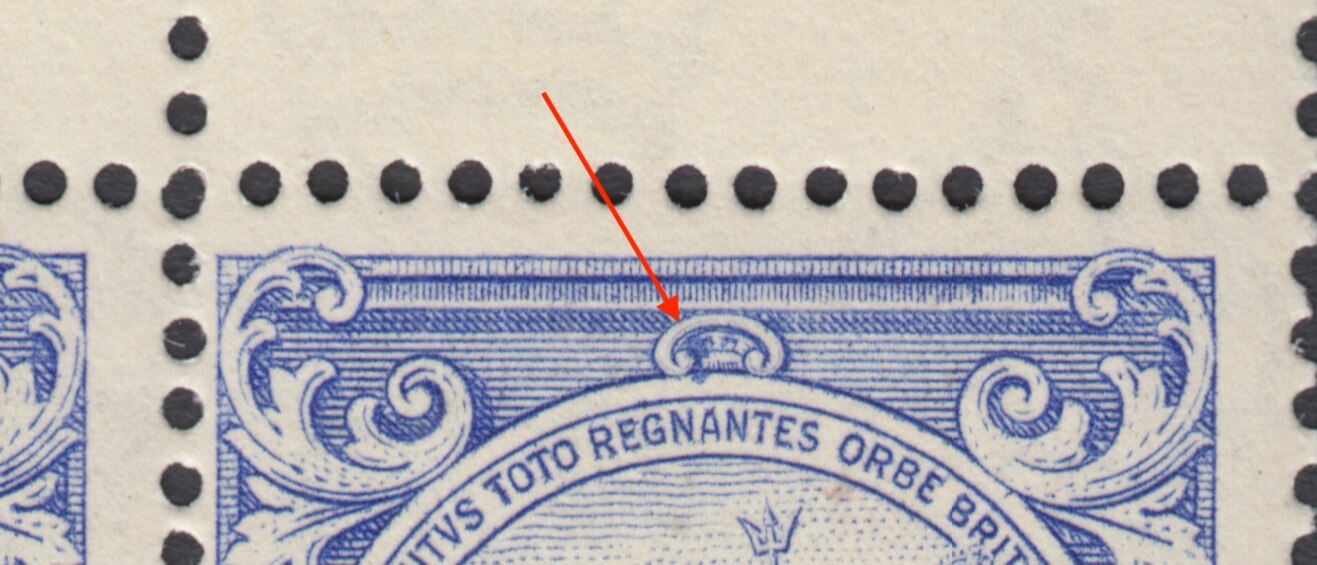
Vertical Line over Horses Head
Only ever appearing on the 3d values in this set, both the brown and the blue, this flaw appears exactly as it is described.
The line is set against the much paler background, making it a lot easier to spot in the central area of the stamp. It is a short, slightly curved line that appears directly above the lower horses head.
Unfortunately, I don’t have a sheet or block containing the flaw so you can see where it is positioned, but when you see the flaws (below) you can see that they are immediately obvious.
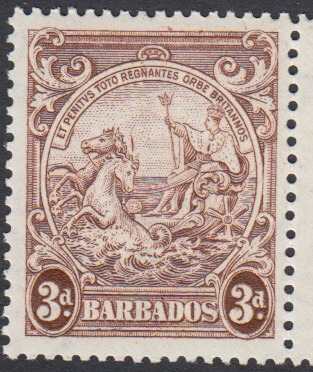
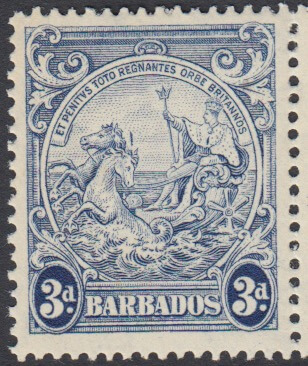
It is worth noting however that used copies are harder to spot than mint, as the postmark or cancel can often sit over the top of the flaw, and over inking can obliterate it completely on occasions.
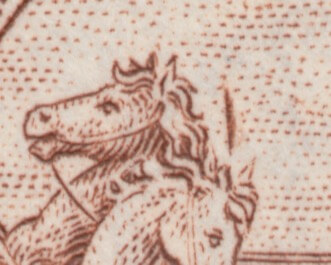
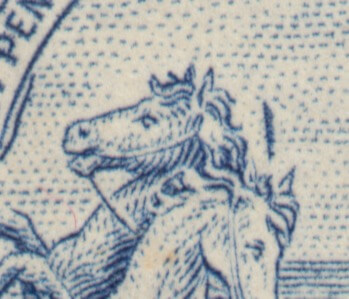
Flying Mane
Finally, we come to the 4d black value in this series; the value with the biggest number of visible flaws on it. Not only do the flaws appear on the earlier printings which were stamps perforated 13½ x 13, but they also appear on the perf 14 versions as well, which were printed in 1944. This shows that the original plate was used for the 1938 printings, was unchanged for the 1944 printings and these flaws were not corrected until 1947 printings, by which time it was the end of the life of this series.
Starting with the Flying Mane flaw, this is one is quite an obvious and visible flaw but it appears just once in the sheet, so tends to be scarcer than some of the other flaws above.
Much like the ‘vertical line over horses head’ flaw, it is a flaw above the horses head, but this time it is the upper horse which has the extension. It looks like someone has drawn a ‘walnut whip’ on top of the horse’s mane, hence the ‘flying mane’ naming.
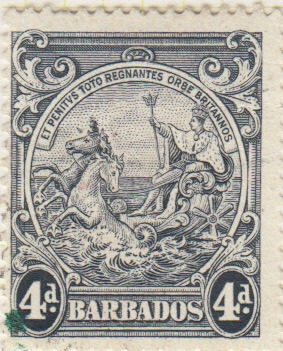
As you can see, it is quite obvious to the naked eye, but getting closer in you can see the detail;
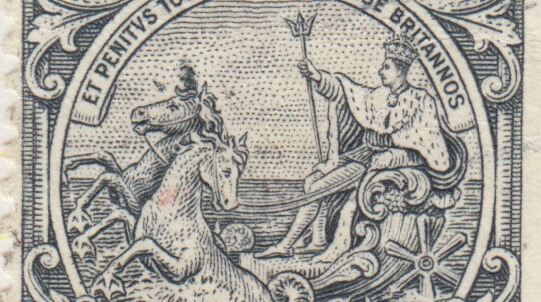
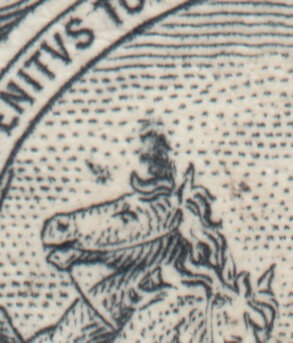
Curved Line at Top Right
As the name suggests, this flaw is quite simply a curved black line at the top right hand of the stamp. The flaw is quite easy to spot and self-evident when you see it. In this pair below, the flaw is in the top right-hand corner of the left-hand stamp;
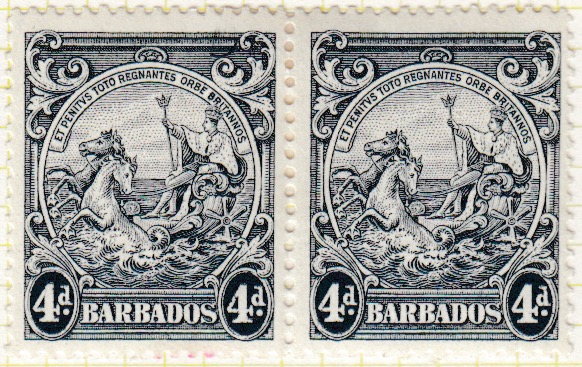
As we move closer in again, it becomes more obvious, looking like something has been trapped on the print like an eyelash, making a curved line;

Finally, when we see it in ultra close up it is obvious;
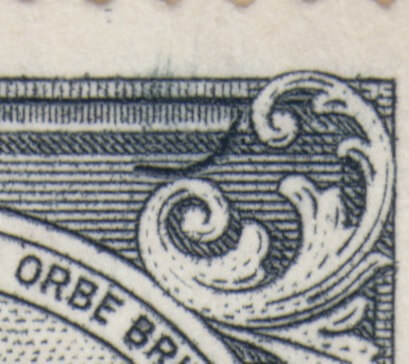
Scratched Plate
This final flaw is much harder to see than the two before. First, you need to know what to look for and then you need to hope, if it is a used copy, that the cancel isn’t too dark.
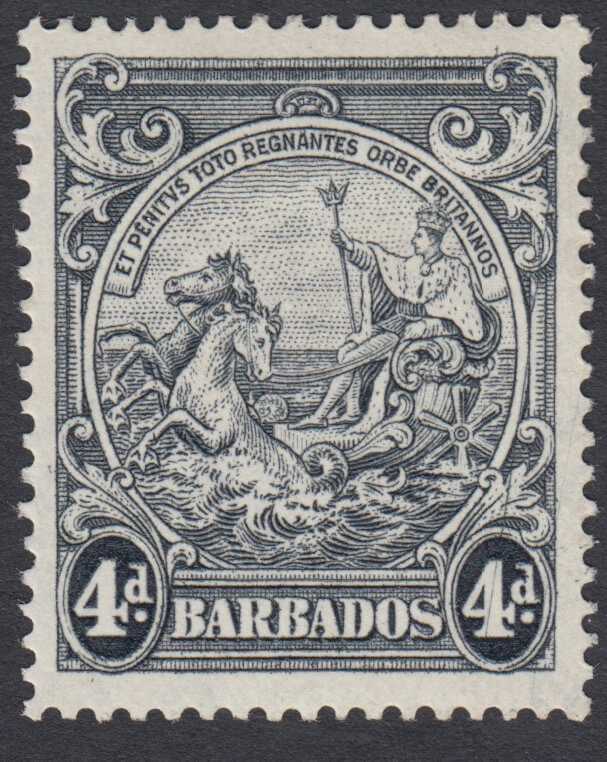
At first glance, it’s not easy to see the flaw, but if you look at the 4d in the lower right-hand value tablet, you can see a thin black line going through it from bottom left towards the top right. this ‘scratch’ or line, extends all the way up until it reaches the stamp frame line about three-quarters of the way up the right-hand side of the stamp.
If we look closer, you can see the crack and to make it easier I’m putting a version of the scan with a red line parallel to the flaw for comparison.
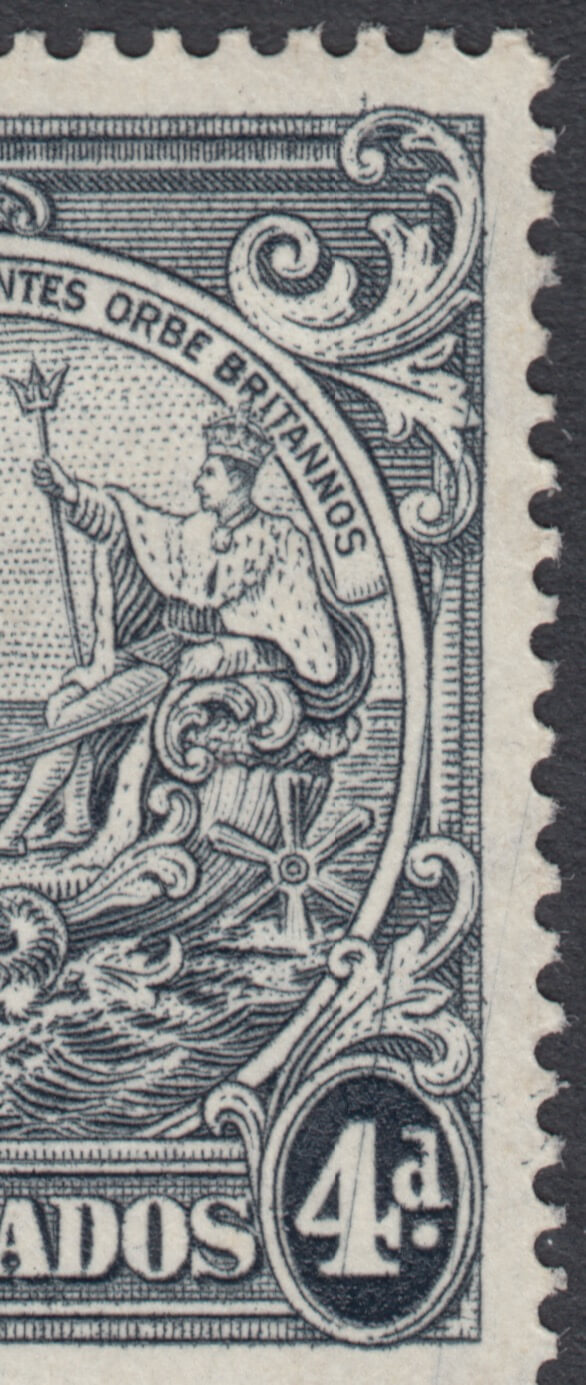
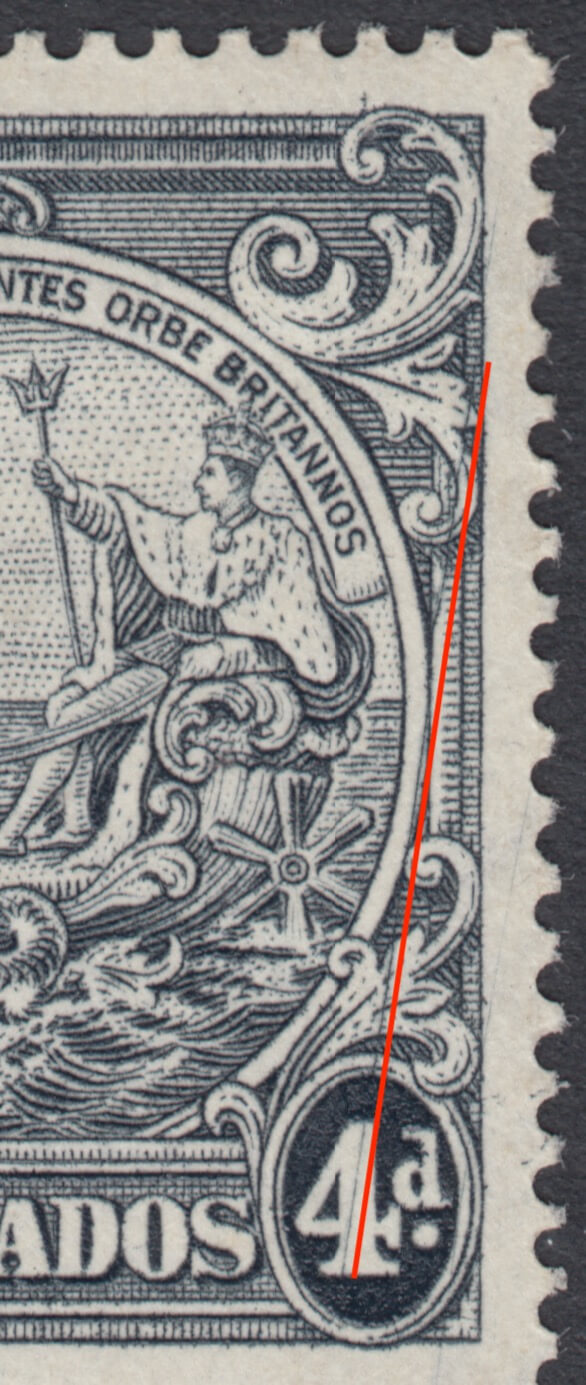
With this flaw, I have been extremely fortunate to find it not only on the stamp, but also on a cover as well.
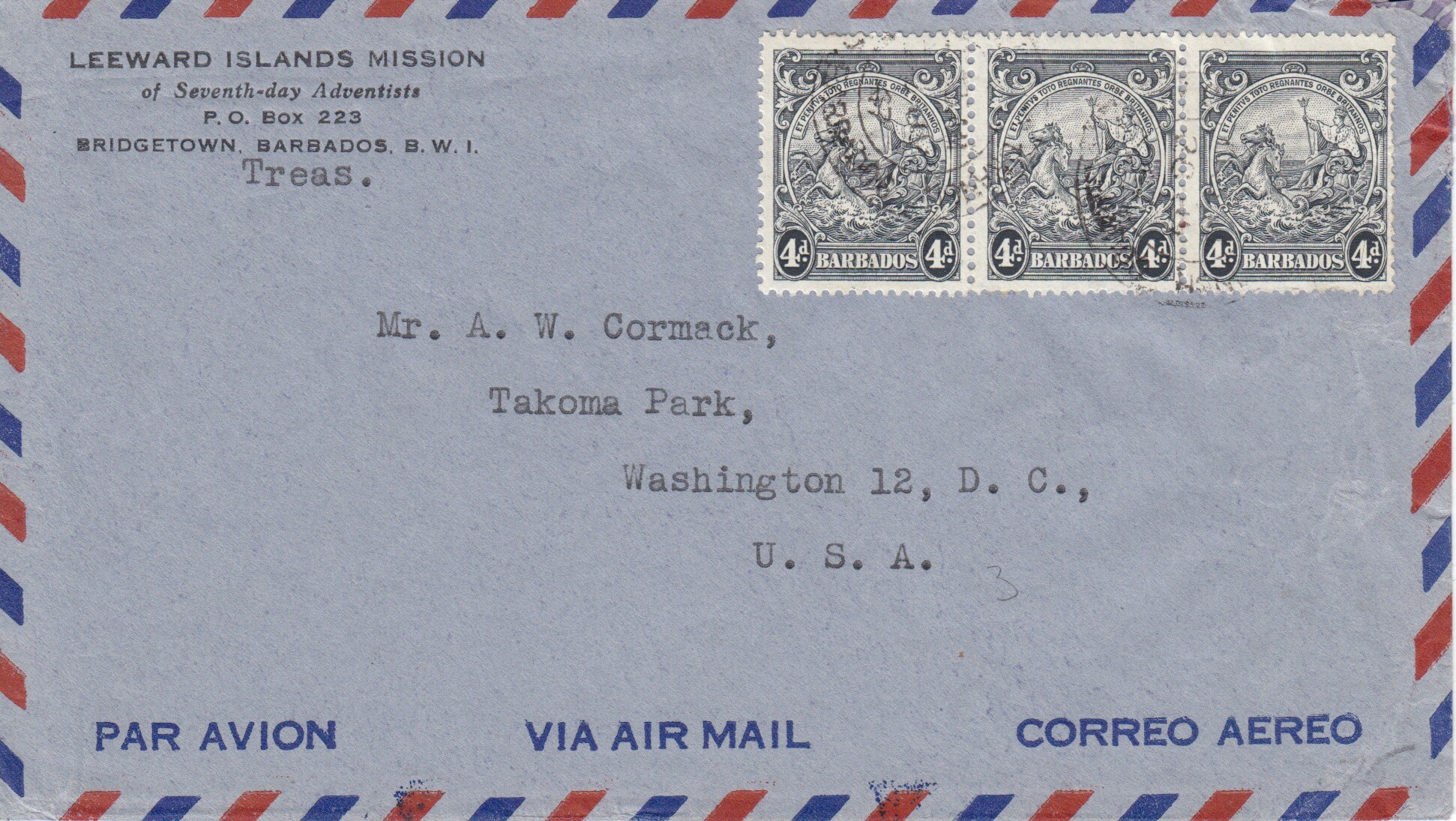
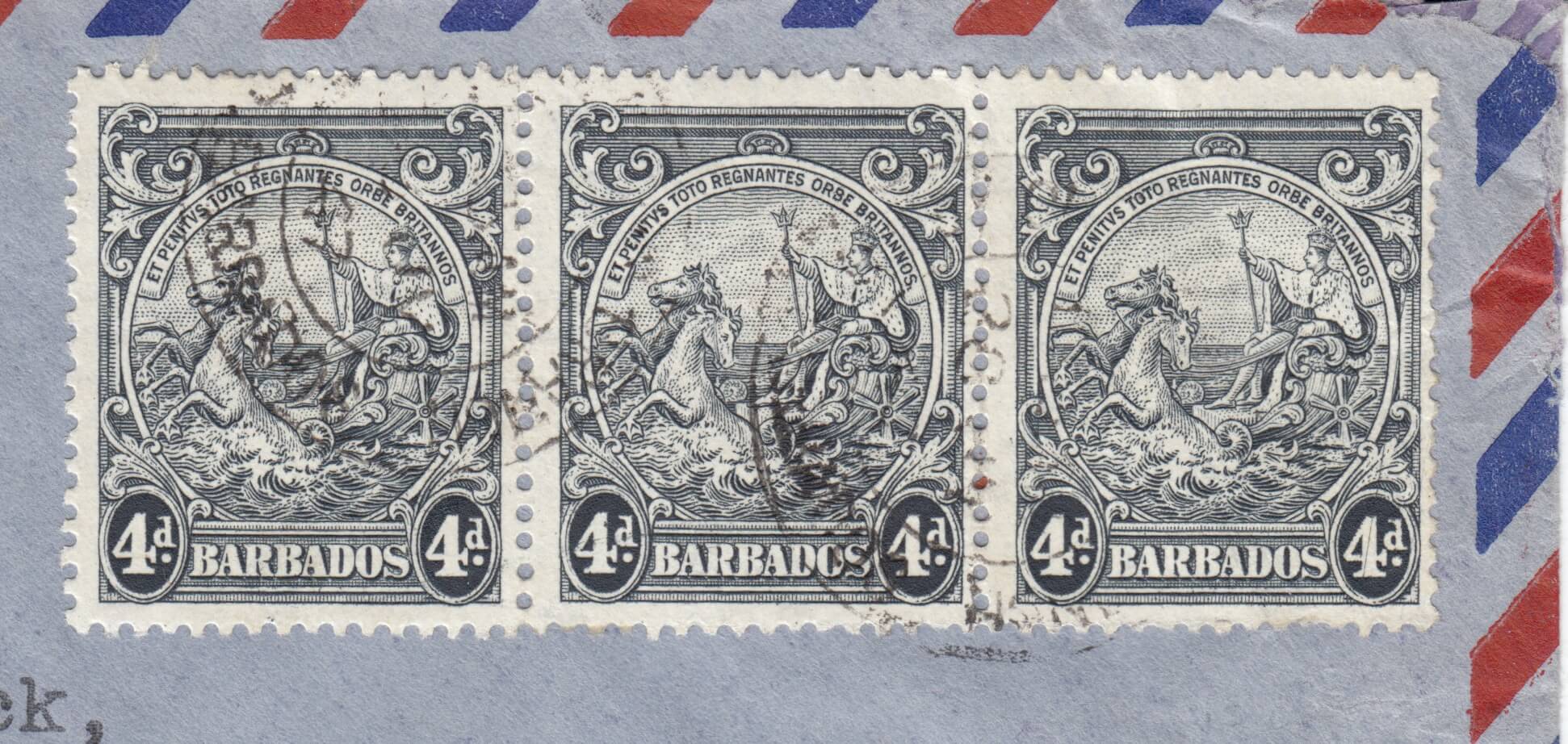
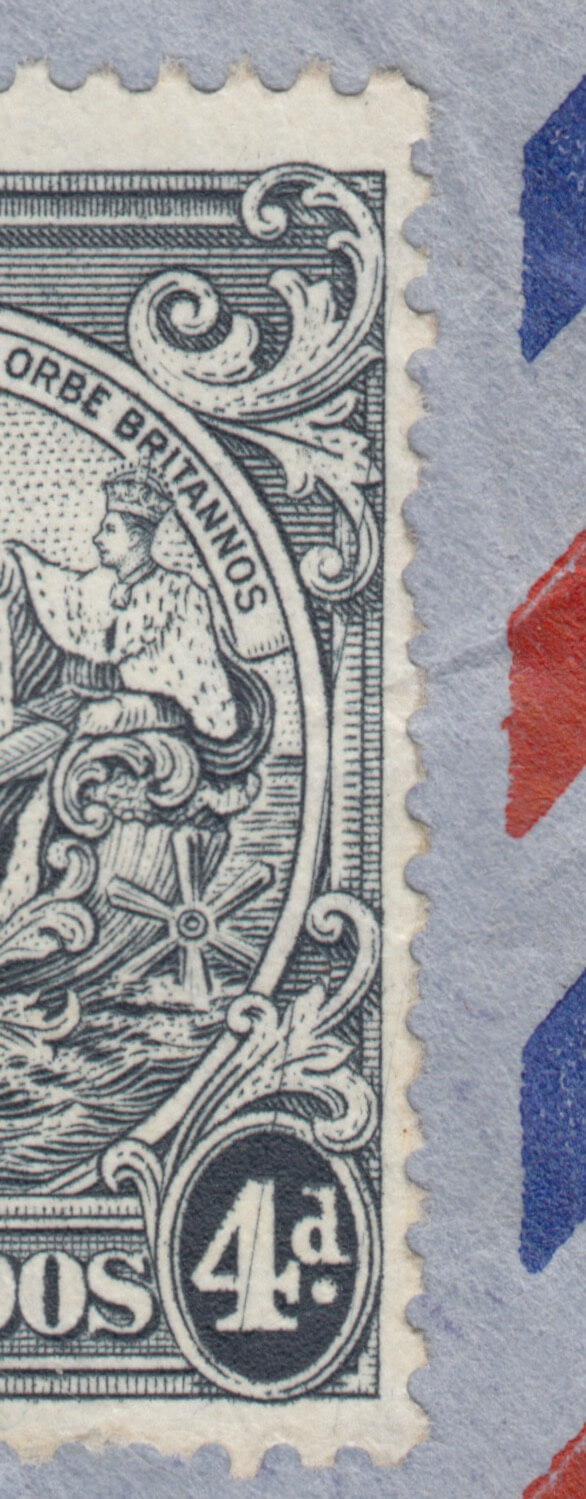
Other flaws
There are many other flaws on Barbados stamps and to date, one of the best resources I’ve found for these and other Commonwealth stamp laws, is on the KGVI Stamp website, specifically their resource pages. To see the flaws for yourself click here.
There is also a useful and informative article from Gibbons Stamp Monthly 1986 on King George VI Varieties, focusing on Barbados, which is reproduced on the King George VI Collectors Society website, as part of their resources. To read that article click here.
This latter article shows some other flaws, weak entries and retouches which haven’t gained full catalogue status, including the ‘missing shaded bars’ flaw which occurs on a number of stamps in the series. Here are some images to give you an idea;
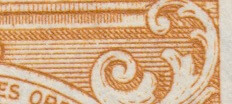
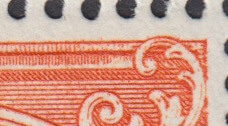
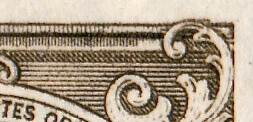
Having found this on three values we expect that there will be other values yet to be discovered with this anomaly.
Conclusion
Collecting flaws in an interesting and challenging part of the hobby, but not one for those with limited time, patience or money. Most of the flaws listed here are catalogued over £100 now and whilst they are still readily available, their scarcity will always drive the price up. Nice if you have the funds to invest, but challenging if you are trying to complete a project including all the flaws.
This article has been designed to simply help you spot the flaws when you see them, either online or in dealers books. These flaws are still out there and there are lots still to be found. Hopefully, this article will encourage you to go find some!
